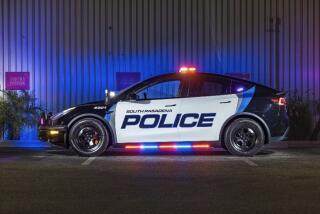Electric cars are getting as cheap as gasoline rivals
What would it take to get you into an electric car today?
Forced by state regulators to sell more zero-emission vehicles, automakers are tripping over each other to offer consumers rock-bottom lease deals. For the first time, electric vehicles are penciling out cheaper than their gas-powered counterparts.
Honda joined the price war this week by dropping the lease on its Fit EV from $389 to $259 a month. It threw in collision and vehicle theft coverage, maintenance, roadside assistance — even a charging station at your house. Factoring in a state rebate, a customer can drive off the lot with an all-in, three-year commitment of less than $7,000. That may make the Fit EV the cheapest $37,000 car in history.
Electric car comparison test: EV specifications
Still, the Honda will have to compete with recently announced $199-a-month leases on the Nissan Leaf, the Fiat 500e and the Chevrolet Spark. Ford is offering its Focus EV for $284 a month.
If you’re looking to buy, state and federal incentives can shave as much as $10,000, nearly a third of the sticker price on a typical model. But automakers are promoting leases to ease consumer fears about maintenance costs and resale values.
Credit California’s tough pollution laws for the EV price war. The California Air Resources Board has mandated that zero-emissions vehicles must account for 15% of all new vehicle sales by 2025, up from less than 1% now. That has automakers scrambling to get consumers into a set of green wheels, even though they are losing money on every car.
Video review: 2013 Honda Fit EV
So far, consumers have largely rejected battery-powered cars as expensive and impractical. Most run out of juice after about 80 miles; recharging takes hours.
Even in California — where the Toyota Prius hybrid is now the best-selling car — fully electric vehicles still sell in tiny volumes. Only about 15,000 have been sold in California since 2008, according to registration data from R.L. Polk & Co., the automotive consulting firm. Nationally, buyers have registered nearly 32,000 electric vehicles.
Palo Alto-based Tesla Motors Inc. has managed to carve out a successful niche selling high-end electric sport sedans — its Model S can cost more than $100,000. But lower-priced models from major automakers barely register on sales charts. Before slashing its lease price this week, Honda had sold a mere 174 Fit EV hatchbacks since July, according to the automaker.
Up to now, most buyers of expensive electric cars have been motivated by social concerns such as energy independence or the environment, said John O’Dell, a green car expert for auto information company Edmunds.com. The spate of cheap leases represents a play for average consumers.
“The bottom line is that, for the mass market, money drives the decision – what’s in it for me?” O’Dell said. “If it’s going to cost more for a vehicle that doesn’t have the same utility, I’m not going to buy it.”
From a public policy standpoint, the goal is to boost consumer demand in the nation’s largest auto market, hoping that bigger sales can spur research and development to lower the technology’s cost.
“As we move beyond early adopters to what we call ‘fast followers,’ economics and cost are going to play a bigger role,” said Mike Ferry, transportation programs manager for the California Center for Sustainable Energy, a San Diego nonprofit that manages the state’s zero-emission vehicle rebate program. “Engineering will get better, costs will come down, and consumer needs will be better met.”
If most EV drivers are motivated by politics or finances, Matt Walton represents the exception. The Moorpark resident just loves their sharp handling and quick start off the line.
“I’m glad it’s good for the environment,” said Walton, 58. “But for me, I just like the driving experience. I had old British sports cars, and in the electrics, I really feel connected to the road in the same way those older vehicles were.”
A retired medical equipment manager, Walton was willing to pay a staggering $850 a month back in 2009 to lease an electric Mini Cooper as part of a BMW test program. He moved on to a Honda Fit with a $389-a-month lease payment that was a bargain by comparison.
So Walker said he was “ecstatic” this week to learn Honda would automatically drop his payment to $259 to match what new customers will pay, and even more excited that Honda eliminated the 12,000 mileage limit.
“As a business decision, I have no idea why they did it,” Walton said. “But I’m not complaining.”
Whether an electric car works for you depends heavily on your driving needs. These cars have limited range — about 80 miles — and they take hours to recharge. To help you decide, we have driven and ranked these three leading entrants in the increasingly competitive micro-segment of the green car world.
Here’s how they stacked up:
Nissan Leaf
Although most automakers have remained wary of battery electrics, Nissan Motor Corp. has been the true believer. It paid a heavy price to bring the Leaf to market in 2011, way ahead of other automakers — about $5 billion invested so far. But the company has acknowledged disappointing sales. Nissan has responded by attacking the car’s two biggest weaknesses — price and charging time. The entry-level 2013 Leaf came down $6,400 from the previous year, to $28,800, the lowest sticker price in our test group. An improved on-board charger cut the Leaf’s charging time in half, to about four hours. (The $199 lease doesn’t include the new charger, a $1,300 option.)
None of those improvements, however, addresses the aesthetics of the Leaf. It remains ugly, in an eco-chic sort of way. Oblong headlights protrude like insect eyes from its short, sloped hood. And its bulging lower body, tapered toward the roof, give the Nissan an awkwardly overweight rear profile.
Inside, even with the leather package on our test car, the Leaf had a downmarket feel. The dashboard is a large slab of hard plastic, embedded with gaudy red, white and blue electronic readouts. The dash makes funny noises too when you put the car in reverse, for instance. The beeps and burps had a video game quality, as if you are cruising in the Super Mario-mobile chasing energy mushrooms.
The cab-forward look does pay some dividends in usable interior space, and the Leaf could function well as a five-seat family car. Interior room for passengers closely tracks with Honda’s Fit. But the Leaf has considerably less cargo room with the rear seats folded down, 30 cubic feet compared to the Honda’s cavernous 49.2 feet.
It’s also less engaging to drive. Like all electric cars, the Leaf accelerates briskly from a standstill, thanks to all that low-end torque. But that power tailed off dramatically as the Leaf gained speed. Its zero to 60-mph time of about 10 seconds, according to Car and Driver magazine, trails the Fit and the 500e by more than a second.
As for the suspension, our tester Leaf soaked up bumps well, adding to a smooth and eerily silent ride. But the car wallowed more in turns than either competitor.
It also costs more. Though the Leaf has the lowest sticker price, that’s for a bare-bones model. Our test car, with options, ran the sticker price up to $36,840, which would increase the monthly lease cost accordingly. Nissan’s lease also requires a $1,999 down payment, compared to nothing for the well-optioned Honda and $999 for the Fiat.
In the final analysis, the Leaf is a good value for the money, after subsidies, compared to many gas-powered and hybrid economy cars. But it falls short of new electric competitors on styling, performance and price. That’s a shame, given Nissan’s early and hard-charging entry into the expensive and speculative EV market.
Fiat 500e
Nothing about the 500e screams “green car!” There’s no garish “ZERO EMISSIONS” or “EV” stickers on the side. Compared to other gas-powered 500s, the electric cousin looks more mean than green, with the only styling tweak being an aggressive lower front grille.
That’s not surprising, because Fiat designed the 500 as a stylish and sporty subcompact first — something to compete with the likes of the Mini Cooper — and was simply fitted the electric drivetrain to appease California regulators.
From the moment you mash the accelerator, it’s clear that electricity is a great match for the 500’s tiny frame and sporting character. The car blasts out of the hole with a silent rush of torque that rips the front tires loose. The sensation feels somewhat like being shot out of an air gun in a giant rubber pellet.
The 500e excels too on fit and finish. Its retro cabin is fitted with the same hard plastic as the Leaf, but the textures look and feel more expensive. Adding to the upscale feel, the Fiat displayed best build quality in this bunch, soaking up rough roads impressively for such a tiny car with a short wheelbase. If you want low-buck zero-emissions with no compromise in driving dynamics, buy the Fiat.
The compromises come in utility. This is a much smaller, less practical car than the Honda or the Nissan. It has a tiny back seat and relatively little cargo room, even with the rear seats folded down.
But who cares? This is your second car. Take your diesel station wagon on the family vacation. Drive the 500e solo to work and play, speeding along in the car-pool lane and laughing all the way past the gas pump.
From the looks of the 500, no one will know you are driving an electric car. This may hurt the Fiat with the look-at-me, eco-self-conscious crowd, but frankly it’s time to move past the era of eco-friendly cars as status symbols. With automakers rolling out a diverse cast of terrifically efficient cars — gas, diesel, hybrid, electric, fuel cell, whatever — green has gone mainstream.
Honda Fit EV
You get no choices in the matter of the Honda Fit EV. Honda has made all the decisions for you. It comes in one color — electric blue, fittingly — and one trim level: loaded, with navigation, three driving modes, heated seats and alloy wheels. You can’t even buy the car. Honda will only lease it to you.
Still, the electric Fit delivers. Like its gas-powered cousin, it offers nimble handling, good looks, stunning interior space and utility. Gas or electric, the Fit is an effective crossbreed of a minivan and a sports car.
The electric adds another layer of standard equipment, performance and, of course, efficiency. The Fit EV makes 123 horsepower and 189 pound-feet of torque, compared to the standard Fit’s 117 horsepower and 106 pound-feet of torque.
The EV carries about 700 extra pounds of battery to go with the extra power, which gives the gas-powered Fit an advantage in handling and steering feel. But the electric Fit handles plenty well enough for the likely uses of its tiny group of potential buyers.
The Fit essentially blends the best attributes of the Fiat 500e and the Nissan Leaf into one extremely versatile, fun to drive package. Three smartly calibrated driving modes, in particular, set the experience apart. Want to cruise quietly and extend the range? Set the car on ECON and enjoy a smooth, silent ride. Want to actually drive? Select sport mode — which turns the dash lights an angry red — then mash the accelerator and hold on.
The Fit turns zero to 60 mph in a respectable 8.7 seconds, according to Car and Driver. But like the Fiat, the bulk of that power is concentrated in the zero to 30-mph range, where it’s appreciated most in an urban driving environment like Los Angeles.
The Fit EV does have a few quirks, as if Honda rushed it to market without some finishing touches. The big plastic dash in our test car had some sloppy gaps at the seams, uncharacteristic of Honda’s typically solid fit and finish. The old-school “ignition” — you turn an actual metal key to start the car — seemed oddly quaint for a futuristic car in an era of push-buttons, remotes and apps.
But such nitpicking isn’t likely to stop Honda from meeting its modest goal of leasing 1,100 Fit EVs combined in this model year and the next. Now that’s its priced right, maybe even below market, Honda might even get more business than it can handle.







